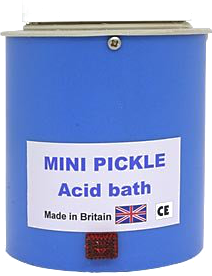Pickling: Difference between revisions
From DT Online
(Created article) |
mNo edit summary |
||
| Line 13: | Line 13: | ||
A small amount of [https://en.wikipedia.org/wiki/Sodium_bicarbonate '''Bicarbonate of Soda'''] ''(aka '''Baking Soda''')'' mixed in a bowl of water can be used as a bath to neutralise the acid after pickling to halt its corrosive effects, but ensure that the workpiece and any tools used are thoroughly rinsed afterwards if they are to be placed back into the pickle bath - otherwise the acid will become weakened. The solution will bubble when the workpiece is placed into it if the solution is strong enough - simply add more bi-carb if this is not the case. | A small amount of [https://en.wikipedia.org/wiki/Sodium_bicarbonate '''Bicarbonate of Soda'''] ''(aka '''Baking Soda''')'' mixed in a bowl of water can be used as a bath to neutralise the acid after pickling to halt its corrosive effects, but ensure that the workpiece and any tools used are thoroughly rinsed afterwards if they are to be placed back into the pickle bath - otherwise the acid will become weakened. The neutralising solution will bubble when the workpiece is placed into it if the solution is strong enough - simply add more bi-carb if this is not the case. | ||
Revision as of 18:21, 15 May 2017
Description
Pickling is the process of immersing metals in a diluted solution of acid (or an acid salt) in order to remove surface scaling and oxides created when heating metal, and the residue of fluxes following any Soldering operations.
Pickling Liquor
Traditionally, the acid pickle (i.e. Pickle Liquor) used for Copper, Brass, and Silver is a 5% to 10% solution of Nitric Acid or Sulphuric Acid (i.e. one third the strength of car battery acid or less). Sodium Bisulphate] is a less aggressive alternative now commonly used by craft workers - it is available as a pH Reducer for swimming pools and hot tubs (add about 250ml of powder to 5 litres of water). Much safer chemicals such as Citric Acid (15% solution), Alum (25% solution) and even Salt and Vinegar ( 1 part salt to 8 parts water) can be used but these tend to be slower acting or have other disadvantages (e.g. Citric Acid will go mouldy if left).
A small amount of Bicarbonate of Soda (aka Baking Soda) mixed in a bowl of water can be used as a bath to neutralise the acid after pickling to halt its corrosive effects, but ensure that the workpiece and any tools used are thoroughly rinsed afterwards if they are to be placed back into the pickle bath - otherwise the acid will become weakened. The neutralising solution will bubble when the workpiece is placed into it if the solution is strong enough - simply add more bi-carb if this is not the case.
Equipment
All Pickle Liquors work more effectively if they are used warm. Specialist temperature controlled Pickling Units are available but many craft workers use the less expensive Electric Slow Cookers
. It is important that these have ceramic and not metallic liners.
Use Brass or Plastics tongs and tweezers to retrieve workpieces from the pickle bath and remove all steel or iron binding wire before pickling - Ferrous Metals will contaminate and weaken most Pickle Liquors.
Safety Advice
- NEVER add water to concentrated acid - ALWAYS add acid to water in that order.
- Whatever equipment is used it must NEVER be later used for working with food!.
- ENSURE the work area is well ventilated.
- PROTECT hands with gloves, eyes with safety goggles and wear a good particulate face mask.
- ALWAYS wash hands after pickling.
- ALWAYS switch off heated pickle baths after use.
Disposal
All Pickle Liquors, even those based on vinegar for example, are contaminated with metal deposits and may be classified as Hazardous Waste. The spent Pickle Liquor can be neutralised with Bicarbonate of Soda and metallic deposits can be filtered out but users should seek Local Authority advice on its disposal.
